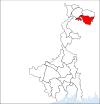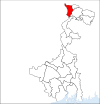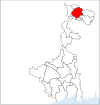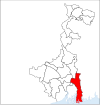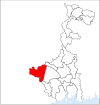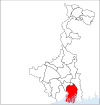List of districts of West Bengal
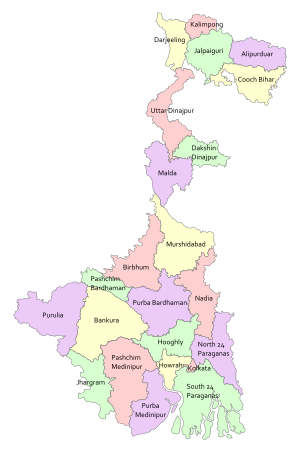
The Indian state of West Bengal is divided into 19 districts. Nepal, Bhutan, Bangladesh and the Indian states of Bihar, Chhattisgarh, Orissa, Assam and Sikkim surround this state. The Himalayas lies in the north of the state and Bay of Bengal is at the south. In between them, the river Ganges flows eastwards and its main distributary Hooghly flows southwards to reach Bay of Bengal. The important Siliguri Corridor that connects North East India with rest of the India, lies in North Bengal region of the state. Geographically, West Bengal is divided into a variety of regions, viz. Darjeeling Himalayan hill region, Terai and Doors region, North Bengal plains, Rarh region, Western plateau and high lands, coastal plains, Sunderbans and the Ganges Delta. In 1947, when India gained independence, the state of West Bengal was formed with 14 districts, as per partition plan of the then Bengal province of British India. Former princely state Koch Bihar joined as a district in 1950 and the former French enclave Chandannagore joined as part of Hooghly district in 1954. States Reorganisation Act of 1956 led to addition of Puruliya district to the state and to enlargement of West Dinajpur district. Later, larger districts like West Dinajpur, 24 Parganas and Midnapore were bifurcated. West Bengal is now divided into 19 districts under three divisions. Districts are administered by District Magistrate and divisions are administered by Divisional Commissioner. Kolkata, the capital of the state, constitutes the Kolkata district. Other districts are further divided into administrative units like subdivisions and blocks, administered by SDO and BDO, respectively. Panchayati Raj has a three-tier structure in the state: the atomic ones are Gram Panchayats, the block-level organizations are called Panchayat Samiti and district-level organizations are named Zilla Parishad.
Geography
West Bengal is bordered by three countries: Nepal, Bhutan and Bangladesh; and five Indian states: Sikkim, Bihar, Chhattishgarh, Orissa and Assam. Sikkim and Bhutan are located at the north of the state, Nepal at the northwest, Bihar and Chhattishgarh at the west, Orissa at the southwest, Bay of Bengal at the south and Bangladesh and Assam are at the east. West Bengal is a unique state of India that has both the Himalayas in the north and Bay of Bengal at the south. In between them, the river Ganges enters the state from west, before it branches off into its main distributaries: Hooghly that flows southwards to reach Bay of Bengal and Padma that flows eastwards into Bangladesh.
The districts which are located at the north of the Ganges, viz. Darjeeling, Jalpaiguri, Cooch Behar, Malda, North Dinajpur and South Dinajpur, are often termed together as North Bengal. Geographically, this area is divided into Darjeeling Himalayan hill region, Terai and Doors region, and North Bengal plains. The important Siliguri Corridor, also known as Chicken's Neck that connects North East India with rest of the India, lies in this region. Indo-Bangladesh enclaves are either enclaves or exclaves of Cooch Behar district.
The districts on the south of the Ganges, viz. Bankura, Bardhaman, Birbhum, Purulia, Murshidabad, Nadia, West Midnapore, East Midnapore, Hooghly, Howrah, Kolkata, North 24 Parganas and South 24 Parganas constitute a variety of geographical regions like Rarh region, Western plateau and high lands, coastal plains, Sunderbans and the Ganges Delta. Kolkata, the capital of the state, constitutes the Kolkata district.
History
When India gained independence in 1947, the province of Bengal was partitioned along religious lines. The western part went to India (and was named West Bengal) while the eastern part joined Pakistan as a province called East Bengal (later renamed East Pakistan, giving rise to Bangladesh in 1971).[1] At the time of its creation in 1947, the state of West Bengal was divided into 14 districts—Bankura, Birbhum, Burdwan, Calcutta, Darjeeling, Jalpaiguri, Hooghly, Howrah, Malda, Midnapore, Murshidabad, Nadia, West Dinajpur and 24 Parganas.[2] Cooch Behar district was a princely state named Koch Bihar till 20 August 1949, when the state formally agreed to join India. Transfer of administration was started on 12 September 1949 and was completed on 19 January 1950, when Cooch Behar became a district of West Bengal.[3] Chandernagore, which was earlier part of French India, had voted to join India in a plebiscite in 1949. Formally, it joined India in 1952 and finally became a part of the Hooghly district of West Bengal on 2 October 1954.[4] States Reorganisation Act of 1956 reorganized boundaries of Indian states along linguistic lines. As this act was implemented, the then West Dinajpur district was enlarged with the addition of some areas from Bihar, and Purulia district was formed on 1 November 1956 from parts of the Manbhum district of Bihar.[5]
Later, some large districts were divided into smaller districts. The district of 24 parganas was bifurcated into two districts—North 24 Parganas district and South 24 Parganas district, with effect from 1 March 1986.[6] On 1 April 1992, the West Dinajpur district was bifurcated into North Dinajpur district and South Dinajpur district.[7][8] With effect from 1 January 2002, the erstwhile Midnapore district was bifurcated into Purba Medinipur district and Paschim Medinipur district.[9]
Since 2007, the demand of a separate Gorkhaland state has been revived by Gorkha Janmukti Morcha and its supporters in Darjeeling hills.[10] Kamtapur People's Party and its supporters' movement for a separate Kamtapur state covering the North Bengal has also gained momentum in 2000's.[11]
Administrative structure

A district is governed by a District Collector, who is better known as a District Magistrate (DM) in the state of West Bengal.[12] DM is either an IAS officer or a WBCS officer and is appointed by State Government of West Bengal.[12] Each district is divided into subdivisions, except Kolkata district, which contains urban area only. A subdivision is governed by a sub-divisional magistrate (SDM), better known as Sub-Divisional Officer (SDO).[13] Other than urban units like town municipalities, a subdivision contains 'community development blocks' (also known as CD blocks or simply, blocks). A block consists of urban units like census towns and rural units called gram panchayats. A block is administered by Block Development Officer (BDO), who is appointed by Government of West Bengal.[12]
A gram panchayat, which consists of a group of villages, is administered by a village council headed by a Pradhan.[14] As per the West Bengal Panchayat Act, 1973, each Block has a Panchayat Samiti, whose members include Pradhans of constituent gram panchayats, and MLAs from the block.[15] A Panchayat Samiti is be headed by a Sabhadhipati.[16] Third tier of Panchayati Raj is Zilla Parishad, a district level organization with Sabhapatis of constituent Panchayat Samitis and MLAs from the district as its members.[17] A Zilla Parishad is headed by a Sabhadhipati.[18] For Darjeeling district, Zilla Parishad has ceased to exist, but a similar organization for Siliguri subdivision exists, which is designated as a Mahakuma Parishad.[19]
Gorkha Hill Council, formed in 1988, administers three (out of four) subdivisions of Darjeeling district: Darjeeling Sadar, Kalimpong and Kurseong.[20] District administration of Darjeeling, which is still responsible for election, panchayat, law and order, revenue etc., also acts as an interface between the Council and State Government.[21]
A District Superintendent of Police, sometimes simply called Superintendent of Police, heads the District Police organization of West Bengal Police. This is as per Police Act of 1861, which is applicable to the whole of India.[22] Superintendents of Police are officers of the Indian Police Service.[23] For every subdivision, there is Subdivision Police, headed by a Police officer of the rank of Assistant Superintendent of Police or Deputy Superintendent of Police.[24] Under subdivisions, there are Police Circles, headed by an Inspector of Police.[24] A Police Circle consists of Police Stations, headed by an Inspector of Police, or in case of rural areas, by a Sub-Inspector of Police.[24]
Calcutta High Court has the jurisdiction of the state of West Bengal. Though most of the districts have more courts other than a District Court, not every subdivision of the state has a Court.[25]
A group of districts forms a division, which is administered by a 'Divisional Commissioner'. West Bengal is now divided in 19 districts, grouped under three divisions:[26]
| Burdwan Division | Jalpaiguri Division | Presidency Division |
|---|---|---|
|
|
|
Alphabetical listing
See also
References
- ^ Harun-or-Rashid. "Partition of Bengal, 1947". Banglapedia. Asiatic Society of Bangladesh. Retrieved 2006-10-26.
- ^ Chatterji, Joya (2007). The Spoils of Partition: Bengal and India, 1947-1967. Cambridge University Press. p. 58. ISBN 0521875366. Retrieved 2008-12-08.
- ^ a b "Brief History of Cooch Behar". Official website of Cooch Behar district. Retrieved 2008-09-10.
- ^ "States of India since 1947". World Statesmen website. Retrieved 2008-11-07.
- ^ a b "District profile". Official website of Purulia district. Retrieved 2008-11-18.
- ^ a b c Mandal, Asim Kumar (2003). Google books preview from The Sundarbans of India: A Development Analysis. Indus Publishing. pp. 168–169. ISBN 8173871434. Retrieved 2008-09-04.
- ^ a b "Home page". Official website of Uttar Dinajpur district. Retrieved 2008-09-01.
- ^ a b "Historical Perspective". Official website of South Dinajpur district. Retrieved 2008-09-01.
- ^ a b c Jana, Naresh (2001-12-31). "Tamluk readies for giant's partition" (HTML). The Telegraph (Kolkata). Retrieved 2008-09-01.
- ^ "Call for Gorkhaland renewed". Darjeeling Times. 2007-10-07. Retrieved 2008-12-11.
- ^ Indo Asian News Service (2008-06-25). "West Bengal faces another blockade, this time for Kamtapur state". AOL India News. Retrieved 2008-12-11.
- ^ a b c "Section 2 of West Bengal Panchayat Act, 1973". Department of Panchayat and Rural Department, West Bengal. Retrieved 2008-12-09.
- ^ Ramesh Kumar Arora, Ramesh Kumar Arora Rajni Goyal. Indian Public Administration: Institutions and Issues. New Age Publishers. p. 298. ISBN 8173280681. Retrieved 2008-12-09.
- ^ "Section 9 of West Bengal Panchayat Act, 1973". Department of Panchayat and Rural Department, West Bengal. Retrieved 2008-12-09.
- ^ "Section 94 of West Bengal Panchayat Act, 1973". Department of Panchayat and Rural Department, West Bengal. Retrieved 2008-12-09.
- ^ "Section 98 of West Bengal Panchayat Act, 1973". Department of Panchayat and Rural Department, West Bengal. Retrieved 2008-12-09.
- ^ "Section 140 of West Bengal Panchayat Act, 1973". Department of Panchayat and Rural Department, West Bengal. Retrieved 2008-12-09.
- ^ "Section 143 of West Bengal Panchayat Act, 1973". Department of Panchayat and Rural Department, West Bengal. Retrieved 2008-12-09.
- ^ "Section 185 of West Bengal Panchayat Act, 1973". Department of Panchayat and Rural Department, West Bengal. Retrieved 2008-12-09.
- ^ "Memoranda of Settlement - DGHC". Darjeeling Times. Retrieved 2008-12-11.
- ^ "History of Darjeeling: Darjeeling-Today". Official website of Darjeeling district. Retrieved 2008-12-11.
- ^ "The Police Act, 1861". India Code Legislative Department. Retrieved 2008-12-14.
- ^ "Indian Police Service (Uniform) Rules". Ministry of Personnel, Public Grievances and Pensions, Government of India. Retrieved 2008-12-14.
- ^ a b c "Police Organization of India" (PDF). Commonwealth Human Rights Initiative. p. 9. Retrieved 2008-12-14.
- ^ "Different Courts in West Bengal (Other than High Courts, Kolkata)". Judicial Department, Government of West Bengal. Retrieved 2008-12-14.
- ^ a b "Directory of District, Sub division, Panchayat Samiti/ Block and Gram Panchayats in West Bengal, March 2008". West Bengal. National Informatics Centre, India. 2008-03-19. Retrieved 2008-11-19.
- ^ "NIC Policy on format of e-mail Address: Appendix (2): Districts Abbreviations as per ISO 3166-2" (PDF). Ministry Of Communications and Information Technology, Government of India. 2004-08-18. pp. pp. 5-10. Retrieved 2008-11-24.
{{cite web}}:|pages=has extra text (help) - ^ a b c d e f "Districts : West Bengal". Government of India portal. Retrieved 2008-11-24.
- ^ The state of West Bengal was established in 1947




